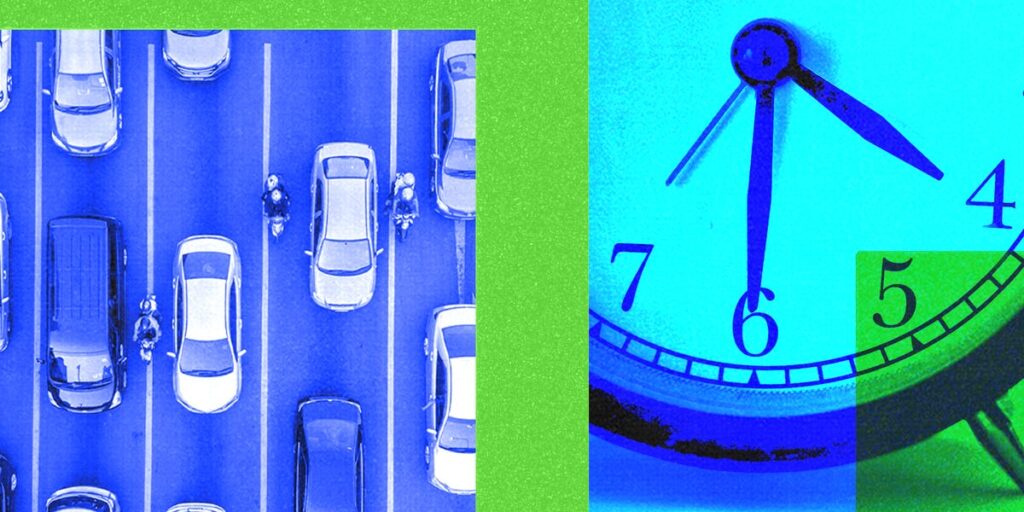After roads that were eerily quiet during the early months of the pandemic, traffic is back with a vengeance. A new report from transportation data and analytics company INRIX finds that traffic congestion is as bad as it was before the pandemic in roughly half of the world’s major cities, but traffic patterns are changing.
Traffic congestion no longer reflects the traditional 9-to-5 work schedule. These days, just as many Americans hit the road at noon as at 5 p.m. Average daytime hourly traffic volume has increased 23% since 2019, according to an INRIX study.
The recent adoption of new remote and hybrid work practices and increases in car ownership are changing traffic and congestion patterns.
According to the INRIX report, the traditional morning rush hour peak has been replaced by a steady pace of trips starting later in the morning. The number of car trips starting at 6 a.m. on weekdays has fallen from about 80 million per day in 2019 to about 50 million in 2023, while trips starting at 9 a.m. have increased from just over 40 million in 2019 to about 60 million in 2023. There are now more than 75 million trips starting between noon and 1 p.m.
Meanwhile, afternoon commutes are increasing and evening commutes are decreasing. Taken all together, it appears that many Americans are moving from their traditional 9am to 5pm commute to noon to 4pm or even shorter work hours.
Bob Pichoux, a transportation analyst at INRIX, said daytime travel began to pick up after the coronavirus outbreak and the trend hasn’t gone away. Remote work has persisted even as many employers pressure employees to spend more time in the office. More flexible work schedules mean people are increasingly going to the grocery store or gym during the day, coming in later or leaving earlier.
“People are still coming in to work later to get their kids to school, coming in at noon or 2 p.m., or coming home earlier for the holidays,” he said.
Cities’ congestion varies depending on where their workplaces are located: “The importance of downtown as a commuter destination is very different in Dallas than it is in New York,” Pichoux said, noting that downtown Manhattan is home to a much larger concentration of local workplaces than downtown Dallas.
INRIX calculates congestion by collecting data from millions of anonymized sensors, cars and commercial vehicles. The report calculates commute times using the time it takes to drive “from major employment centers within a city to the surrounding commuter districts.”
This shift in mobility has many implications for policymakers and transportation planners. Public transportation schedules, road tolls, and even traffic lights have long been designed with the 9-to-5 workday and the rush hours it creates in mind. But transportation data shows that cities may need to adjust schedules and redesign their physical infrastructure to fit the new remote work paradigm post-pandemic.
“This is something we need to pay attention to now,” Pichoux said.
New York City will be the most congested city in the world by 2023, according to an INRIX report. Declan Gill
The traffic jams will continue
Since the pandemic began, public transport ridership has plummeted, while car use has increased.
New York City will be the most congested city in the world by 2023, according to an INRIX report. Last year, New Yorkers lost an average of 101 hours to traffic delays. The city saw a 13% increase in downtown car trips compared to last year, the fastest increase in the country.
Car ownership has also been rising in recent years, including in New York.
Car ownership in the five boroughs has skyrocketed over the past decade. New York City’s resident population grew 1.4% between 2012 and 2021, but the number of registered passenger vehicles increased 12%. Still, about 54% of households in the city reported not owning a car in 2021.
A year into the pandemic, Americans are driving more, even as many offices remain closed: In March 2021, the number of miles driven by people in U.S. cities was 2% higher than in February 2020 and 20% higher than in March 2020, when pandemic lockdowns first went into effect.
The shift from densely populated cities to suburban and even rural living is also contributing to the increase in driving. Many city dwellers have moved farther away to car-dependent suburbs or rural towns during the pandemic, and the trend appears set to continue. For many, this means more time in the car.
Has your commute changed over the years? Share your experience with us at erelman@businessinsider.com.

